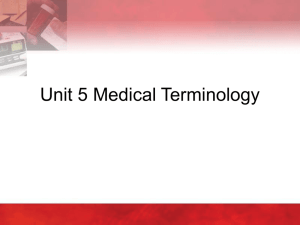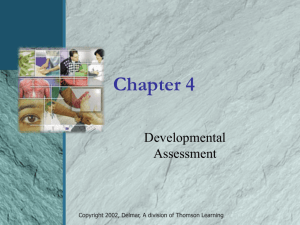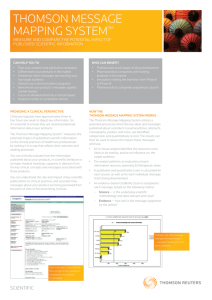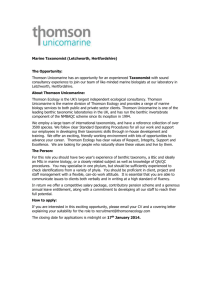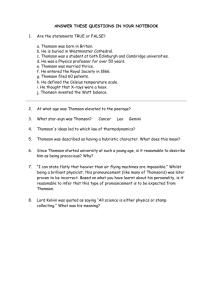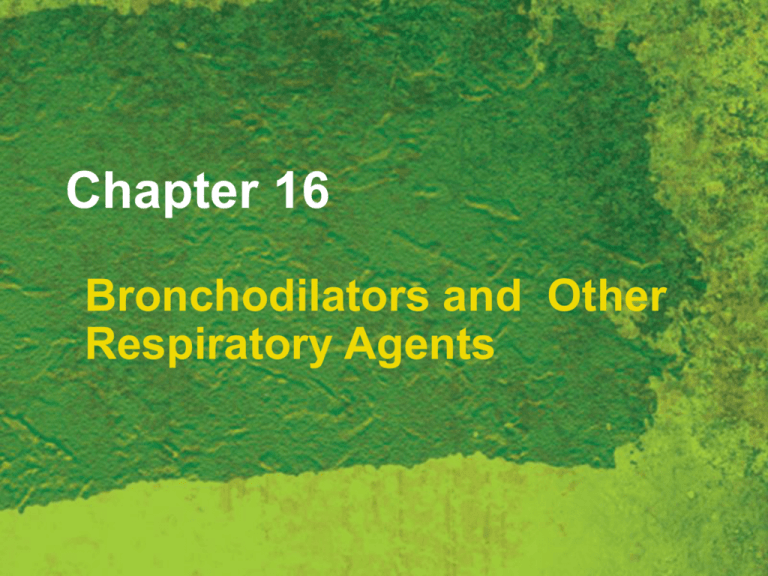
Chapter 16
Bronchodilators and Other
Respiratory Agents
Bronchodilators
Medications used to relax and open the
airways
Open or maintain the bronchial airways
Treat several disease syndromes
Chronic obstructive pulmonary disease
Asthma
16 - 2
Copyright 2007 Thomson Delmar Learning, a division of Thomson Learning Inc. All rights reserved.
Classes of Bronchodilators
Sympathomimetic agents
Xanthine bronchodilators
Anticholinergics
Leukotriene receptor antagonists
5-lipoxygenase inhibitors
Mast cell stabilizers
Corticosteroids
16 - 3
Copyright 2007 Thomson Delmar Learning, a division of Thomson Learning Inc. All rights reserved.
Sympathomimetics
Beta2-adrenergic receptors
Used during the acute phase of asthmatic
attacks
Quickly reduce airway constriction and
restore normal airflow
16 - 4
Copyright 2007 Thomson Delmar Learning, a division of Thomson Learning Inc. All rights reserved.
Uses for Sympathomimetics
Treat acute attacks as well as prevent
attacks
Quickly reduce airway constriction and
restore normal airflow
Relief of bronchospasm, bronchial asthma,
bronchitis, and other pulmonary diseases
Treat hypotension and shock
Produce uterine relaxation to prevent
premature labor
16 - 5
Copyright 2007 Thomson Delmar Learning, a division of Thomson Learning Inc. All rights reserved.
Sympathomimetic Agents
Nonselective adrenergics
16 - 6
Stimulate alpha1, beta1 (cardiac), and
beta2 (respiratory) receptors
Example: epinephrine
(continues)
Copyright 2007 Thomson Delmar Learning, a division of Thomson Learning Inc. All rights reserved.
(continued)
Sympathomimetic Agents
Nonselective beta-adrenergics
Stimulate both beta1 and beta2 receptors
Example: isoproterenol (Isuprel)
Selective beta2 drugs
16 - 7
Stimulate only beta2 receptors
Example: albuterol
(continues)
Copyright 2007 Thomson Delmar Learning, a division of Thomson Learning Inc. All rights reserved.
(continued)
Sympathomimetic Agents
Frequent use leads to beta1 receptors
being stimulated
Albuterol loses its action
General side effects
Nausea, increased anxiety, palpitations,
tremors, and increased heart rate
16 - 8
Copyright 2007 Thomson Delmar Learning, a division of Thomson Learning Inc. All rights reserved.
Xanthines
Chemical class of agents
Contain caffeine
Oldest class of bronchodilators
Used in ancient times
16 - 9
Copyright 2007 Thomson Delmar Learning, a division of Thomson Learning Inc. All rights reserved.
Xanthine Bronchodilators:
Mechanism of Action
Increase levels of energy-producing
cAMP
Inhibit phosphodiesterase
Enzyme that breaks down cAMP
Result
Smooth muscle relaxation
Bronchodilation
Increase airflow (oxygen/carbon dioxide) in
the lungs
Cause cardiac life-threatening side effects
16 - 10
Copyright 2007 Thomson Delmar Learning, a division of Thomson Learning Inc. All rights reserved.
Xanthine Derivatives:
Side Effects
Nausea, vomiting, anorexia
Gastroesophageal reflux during sleep
Sinus tachycardia, extrasystole,
palpitations, ventricular dysrhythmias
Transient increased urination
16 - 11
Copyright 2007 Thomson Delmar Learning, a division of Thomson Learning Inc. All rights reserved.
Anticholinergics: Mechanism of
Action
Acetylcholine (ACh) causes bronchial
constriction.
Anticholinergics bind to the ACh
receptors, preventing ACh from binding.
Result: bronchoconstriction is prevented,
airways dilate
16 - 12
Copyright 2007 Thomson Delmar Learning, a division of Thomson Learning Inc. All rights reserved.
Anticholinergic Bronchodilators
Ipratropium bromide (Atrovent)
Tiotropium bromide (Spiriva HandiHaler)
Actions
Local effects
Slow and prolonged action
Used to prevent bronchoconstriction
Not used for acute asthma exacerbations!
16 - 13
Copyright 2007 Thomson Delmar Learning, a division of Thomson Learning Inc. All rights reserved.
Anticholinergics: Side Effects
Usually not absorbed systemically
If absorbed, have the potential to
produce:
Dry mouth or dry throat
Gastrointestinal distress
Headache
Coughing
Anxiety
16 - 14
Copyright 2007 Thomson Delmar Learning, a division of Thomson Learning Inc. All rights reserved.
Leukotriene Receptor Antagonists
Directly prevent bronchoconstriction
Developed to treat asthma
Popular and effective
Leukotrienes are inflammatory molecules
16 - 15
Released by mast cells
Cause the bronchials to contract
Development of edema in the lungs
(continues)
Copyright 2007 Thomson Delmar Learning, a division of Thomson Learning Inc. All rights reserved.
(continued)
Leukotriene Receptor Antagonists
By blocking leukotrienes:
16 - 16
Prevent smooth muscle contraction of the
bronchial airways
Decrease mucus secretion
Prevent vascular permeability
Decrease neutrophil and leukocyte
infiltration to the lungs
(continues)
Copyright 2007 Thomson Delmar Learning, a division of Thomson Learning Inc. All rights reserved.
(continued)
Leukotriene Receptor Antagonists
Currently available agents:
Montelukast (Singulair)
Zafirlukast (Accolate)
16 - 17
Copyright 2007 Thomson Delmar Learning, a division of Thomson Learning Inc. All rights reserved.
Leukotriene Receptor Antagonists:
Side Effects
Headache
Nausea
Diarrhea
Liver dysfunction
16 - 18
Copyright 2007 Thomson Delmar Learning, a division of Thomson Learning Inc. All rights reserved.
Leukotriene Receptor Antagonists:
Client Education
Educate the client.
Use for chronic management of asthma, not
acute asthma
Improvement should be seen in about
1 week
16 - 19
Copyright 2007 Thomson Delmar Learning, a division of Thomson Learning Inc. All rights reserved.
5-Lipoxygenase Inhibitors
New class of leukotriene receptor
antagonists
Action
Inhibit the formation of leukotrienes
Used to inhibit some cancer growth
Outcome
Prevent lung inflammation
Example
One agent: Zileuton
16 - 20
Copyright 2007 Thomson Delmar Learning, a division of Thomson Learning Inc. All rights reserved.
Mast Cell Stabilizers
Used prophylactically
No direct bronchodilator activity
Indirect-acting
Stabilize the cell membranes of the
inflammatory cells–mast cells,
monocytes, macrophages
16 - 21
Prevent release of harmful cellular contents
(continues)
Copyright 2007 Thomson Delmar Learning, a division of Thomson Learning Inc. All rights reserved.
(continued)
Mast Cell Stabilizers
Adjuncts to the overall management
of clients with lung disease
Prevent bronchospasm when exposed to:
Cold air
Exercise
Allergens
Dry air
16 - 22
Copyright 2007 Thomson Delmar Learning, a division of Thomson Learning Inc. All rights reserved.
Mast Cell Stabilizers: Examples
Cromolyn (Nasalcrom, Intal)
Nedocromil (Tilade)
16 - 23
Copyright 2007 Thomson Delmar Learning, a division of Thomson Learning Inc. All rights reserved.
Mast Cell Stabilizers: Side Effects
Coughing
Taste changes
Sore throat
Dizziness
Rhinitis
Headache
Bronchospasm
16 - 24
Copyright 2007 Thomson Delmar Learning, a division of Thomson Learning Inc. All rights reserved.
Inhaled Corticosteroids
Anti-inflammatory
Inhaled forms
16 - 25
Reduce systemic effects
Used for chronic asthma
Does not relieve acute asthma
(continues)
Copyright 2007 Thomson Delmar Learning, a division of Thomson Learning Inc. All rights reserved.
(continued)
Inhaled Corticosteroids
Stabilize membranes of cells that release
harmful bronchoconstricting substances
Also increase responsiveness of
bronchial smooth muscle to betaadrenergic stimulation
16 - 26
Copyright 2007 Thomson Delmar Learning, a division of Thomson Learning Inc. All rights reserved.
Inhaled Corticosteroids: Examples
Beclomethasone dipropionate
(Beclovent, Vanceril)
Triamcinolone acetonide
(Azmacort)
Flunisolide (AeroBid)
16 - 27
Copyright 2007 Thomson Delmar Learning, a division of Thomson Learning Inc. All rights reserved.
Inhaled Corticosteroids:
Side Effects
Pharyngeal irritation
Coughing
Dry mouth
Oral fungal infections
Systemic effects are rare
16 - 28
Copyright 2007 Thomson Delmar Learning, a division of Thomson Learning Inc. All rights reserved.
Respiratory Agents
Combination product
Fluticasone propionate and salmeterol
(Advair): a dry powder in a circular diskus
Salmeterol: long-acting bronchodilator
Corticosteroid: anti-inflammatory agent
Used daily
16 - 29
Copyright 2007 Thomson Delmar Learning, a division of Thomson Learning Inc. All rights reserved.
Respiratory Agents:
Client Education
Instruct clients to:
Receive flu and pneumonia vaccination
Receive prompt treatment for any illness
Check with health care provider before
taking other medications
16 - 30
Copyright 2007 Thomson Delmar Learning, a division of Thomson Learning Inc. All rights reserved.

